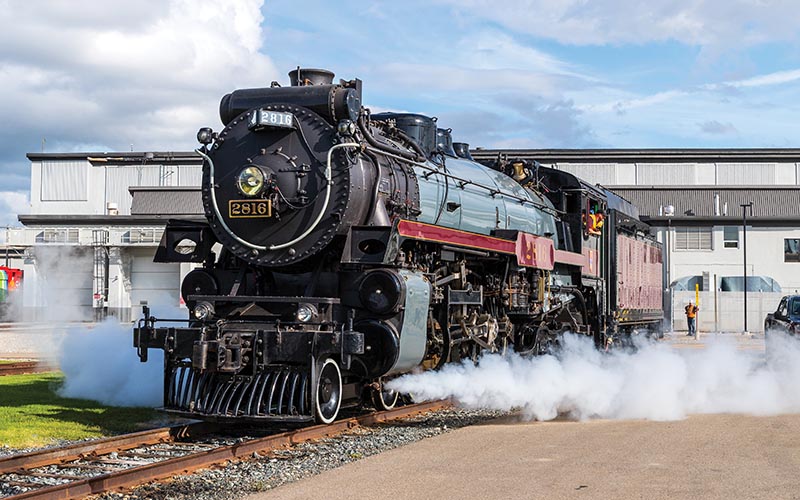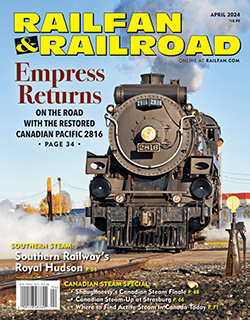 by Justin Franz/photos as noted
by Justin Franz/photos as noted
On a crisp autumn morning, a steady stream of workers turns off Ogden Dale Road southeast of downtown Calgary and onto the E. Hunter Harrison Campus, corporate headquarters for the six-month-old CPKC Railway. Inside gleaming office buildings scattered across the well-manicured grounds, they’ll go about the business of running a modern Class I railroad that now stretches some 20,000 miles from Vancouver to Chicago to Mexico City.
While the sign on Ogden Dale proclaims this to be the headquarters for CPKC, monuments across the campus pay tribute to the railroad’s true identity at heart in this region — Canadian Pacific Railway. Not far from the main office sits a red caboose wearing CP’s iconic script lettering and across the parking lot from that sits perhaps the most important artifact of all — A1e class 4-4-0 29. Built in the railway’s own DeLorimier Shops in 1887, the 69-inch-drivered American had the distinction on November 6, 1960, of being the last CP-owned steam locomotive to lead a train on the railroad — or at least that’s what old history books proclaim. But on this day, October 19, 2023, just a few hundred feet from locomotive 29, stands a simmering contradiction to that historical footnote.
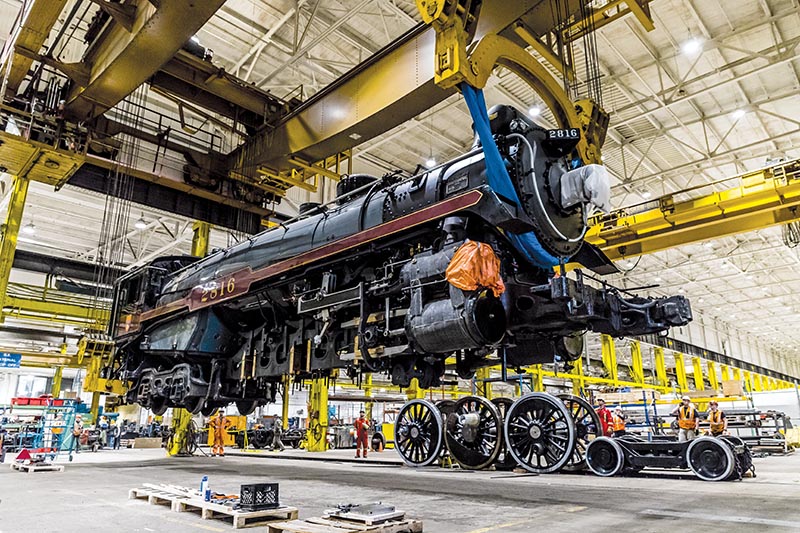
ABOVE: TOP: A major part of 2816’s overhaul was running gear work and the installation of an oil lubrication system based on one used by Southern Pacific 4449. In May 2023, the locomotive was lifted onto its drivers. —Aivo Merimets photo
Canadian Pacific H1b 4-6-4 2816 — also known as “The Empress” — is basking in the morning light building up steam as a crew of a half dozen or so tends to the 93-year-old’s every need. While the locomotive’s rods, boiler jacket, and number boards shine, there’s a thin layer of road grime in harder-to-reach spots, evidence of a round trip to Edmonton the previous two days. But that thin layer only accentuates the appearance of this fine machine. The maroon and pinstriped running board shroud offers the locomotive a hint of streamlining, although it’s still utilitarian compared to its “royal” siblings. The slight curve to the smokestack gives the locomotive the suggestion of European style, perhaps a nod to the fact that six out of 10 CP chief mechanical officers in the steam era were British-born. Of course, the all-weather enclosed cab leaves no doubt about its nation of origin.
This morning, the locomotive is being prepared for a homecoming and its biggest test yet following an extensive, multi-year overhaul — a fast-paced, two-day round trip to Medicine Hat, Alta., the same route on which this Hudson and its sisters ran decades ago.
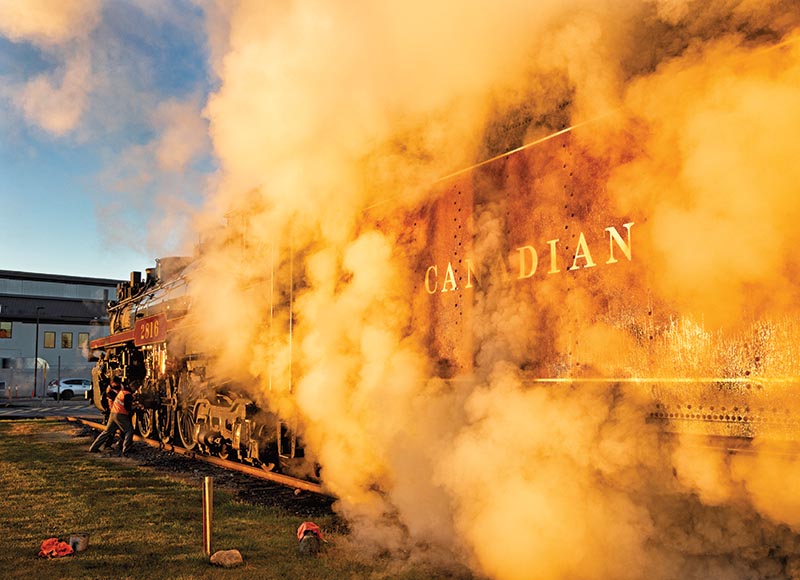
ABOVE: Steam rises in the morning sun as 2816 is prepared for a run east to Medicine Hat on October 19, 2023. —Justin Franz photo
While the 175.8-mile Brooks Subdivision is familiar territory for the locomotive, the idea of a steam locomotive running on a transcontinental main line in North America is considerably less familiar in the 2020s, much less a steam locomotive owned and operated by a major North American railroad. While other Class Is have welcomed steam on their rails in the 21st century — and an American competitor still maintains a program featuring the world’s largest operating steam locomotive — none have resurrected their steam program quite like CPKC. Nor have they ever attempted to do something quite as ambitious as what the 2816’s crew plans to do in 2024 — a more than 8,000-mile journey across three countries that will likely go down in history as one of the longest steam tours ever featuring a single locomotive. Thankfully, CPKC and its crew have an engine that is more than ready for the challenge. But getting to this moment was no easy feat.
“A Superior Breed of Locomotive”
Canadian Pacific 2816 is small by the standards of many main line steam locomotives in North America. While the H1’s approximate 360,000 pounds of total engine weight is comparable to New York Central’s Hudsons (the first road to build a 4-6-4 in North America and where the type got its name), it was considerably smaller compared to the behemoths over on Santa Fe (412,380 pounds) or Chesapeake & Ohio (443,000). But in the steam era, CP found that smaller locomotives better fit its needs, especially in a sparsely populated and spread-out nation that in the early 20th century did not enjoy consistently heavy traffic. As historian and author Omer Lavallée explained in his seminal book Canadian Pacific Steam Locomotives, the story of steam development on the railroad was not “an epic of the mammoth locomotive.”
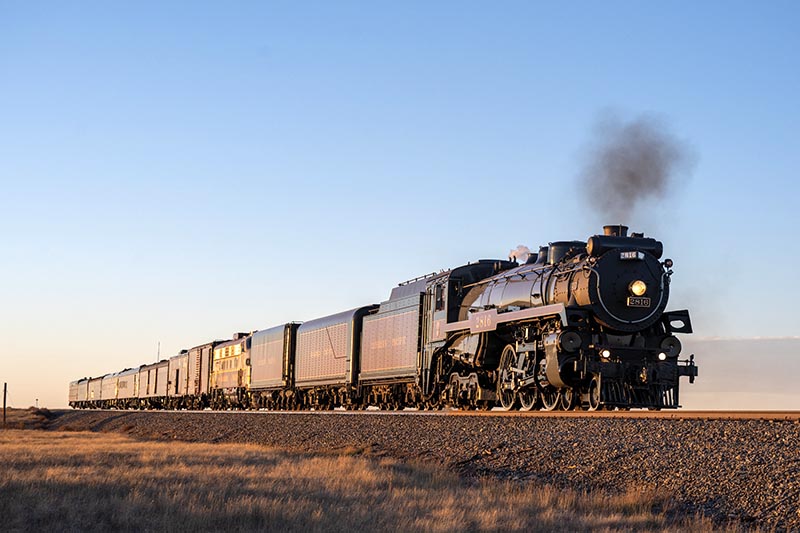
ABOVE: Looking like it’s leading the eastbound Dominion in the 1930s, CP 2816 storms east on the Brooks Subdivision at Bowell, Alta., on October 19, 2023. Four days of fast running in late October, including two days on the CPKC main line, were the final test for the 93-year-old Hudson. By all accounts, it performed flawlessly. —Tom Lambrecht photo
The most common type of CP steam locomotive was the lowly, yet useful, Ten-Wheeler. In fact, of the 3,257 steam locomotives owned by CP between 1881 and the end of steam in 1960, nearly 30 percent of them were of the 4-6-0 wheel arrangement. The next most common were 2-8-0s (16.8 percent of the fleet) and 4-6-2s (15.3 percent). Of the 4-8-4 Northern type — perhaps the quintessential main line steam locomotive in North America — CP owned only two, 3100 and 3101, built in August and October of 1928 at the railroad’s Angus Shops in Montreal.
While the two K1a locomotives were good performers, CP management felt that the big locomotives were more than they really needed, so the 4-8-4s spent most of their careers working passenger service between Montreal and Toronto. On the other hand, CP’s main competitor north of the border, the government-owned Canadian National, embraced the 4-8-4 design fully, eventually owning more Northerns than any other railroad in North America. However, as Lavallée and James A. Brown pointed out in a 1969 story in Trains, CN had a network with lighter rail and older bridges, which necessitated the weight of a large locomotive be spread out on more axles. It was an issue the privately owned CP did not face, especially after upgrading its main line routes throughout the early 20th century…


